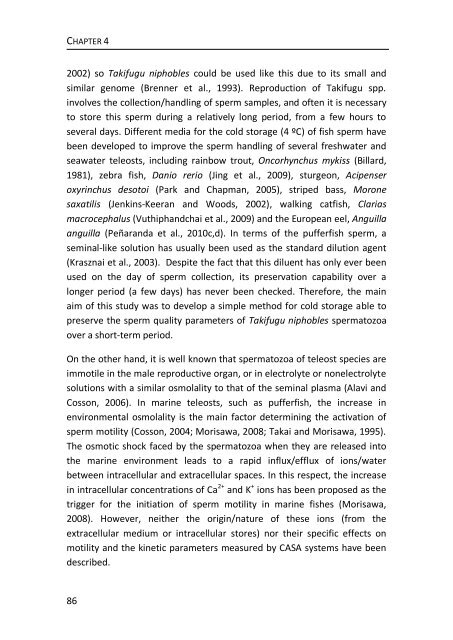chapter 3 - RiuNet
chapter 3 - RiuNet
chapter 3 - RiuNet
You also want an ePaper? Increase the reach of your titles
YUMPU automatically turns print PDFs into web optimized ePapers that Google loves.
CHAPTER 4<br />
2002) so Takifugu niphobles could be used like this due to its small and<br />
similar genome (Brenner et al., 1993). Reproduction of Takifugu spp.<br />
involves the collection/handling of sperm samples, and often it is necessary<br />
to store this sperm during a relatively long period, from a few hours to<br />
several days. Different media for the cold storage (4 ºC) of fish sperm have<br />
been developed to improve the sperm handling of several freshwater and<br />
seawater teleosts, including rainbow trout, Oncorhynchus mykiss (Billard,<br />
1981), zebra fish, Danio rerio (Jing et al., 2009), sturgeon, Acipenser<br />
oxyrinchus desotoi (Park and Chapman, 2005), striped bass, Morone<br />
saxatilis (Jenkins-Keeran and Woods, 2002), walking catfish, Clarias<br />
macrocephalus (Vuthiphandchai et al., 2009) and the European eel, Anguilla<br />
anguilla (Peñaranda et al., 2010c,d). In terms of the pufferfish sperm, a<br />
seminal-like solution has usually been used as the standard dilution agent<br />
(Krasznai et al., 2003). Despite the fact that this diluent has only ever been<br />
used on the day of sperm collection, its preservation capability over a<br />
longer period (a few days) has never been checked. Therefore, the main<br />
aim of this study was to develop a simple method for cold storage able to<br />
preserve the sperm quality parameters of Takifugu niphobles spermatozoa<br />
over a short-term period.<br />
On the other hand, it is well known that spermatozoa of teleost species are<br />
immotile in the male reproductive organ, or in electrolyte or nonelectrolyte<br />
solutions with a similar osmolality to that of the seminal plasma (Alavi and<br />
Cosson, 2006). In marine teleosts, such as pufferfish, the increase in<br />
environmental osmolality is the main factor determining the activation of<br />
sperm motility (Cosson, 2004; Morisawa, 2008; Takai and Morisawa, 1995).<br />
The osmotic shock faced by the spermatozoa when they are released into<br />
the marine environment leads to a rapid influx/efflux of ions/water<br />
between intracellular and extracellular spaces. In this respect, the increase<br />
in intracellular concentrations of Ca 2+ and K + ions has been proposed as the<br />
trigger for the initiation of sperm motility in marine fishes (Morisawa,<br />
2008). However, neither the origin/nature of these ions (from the<br />
extracellular medium or intracellular stores) nor their specific effects on<br />
motility and the kinetic parameters measured by CASA systems have been<br />
described.<br />
86
















